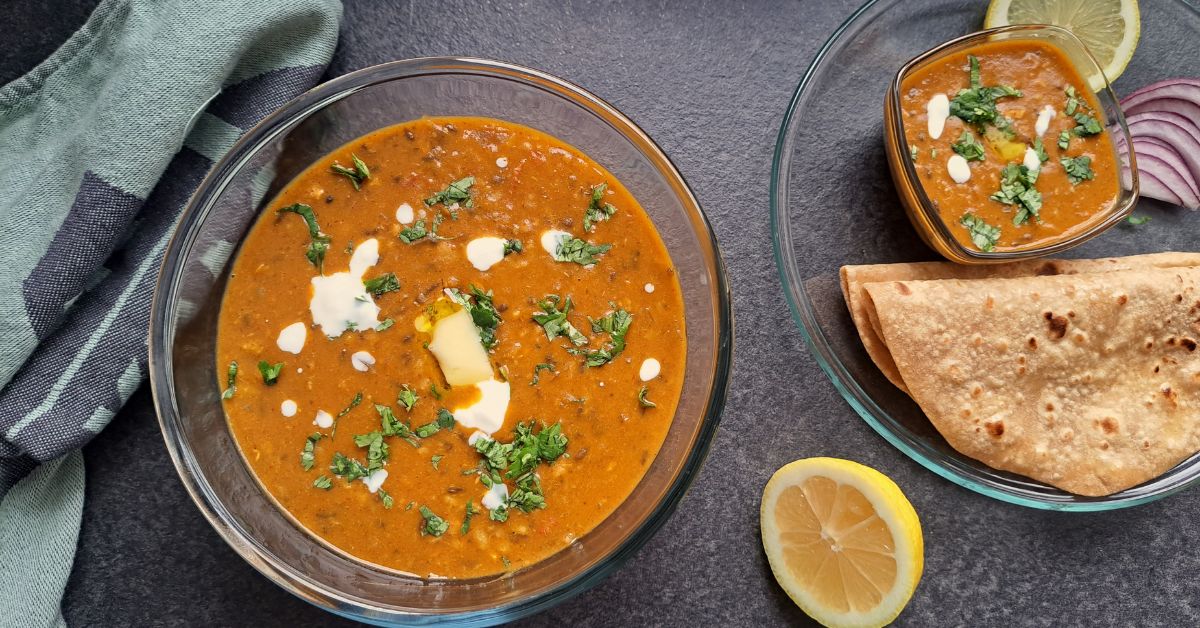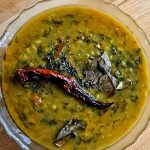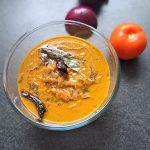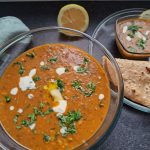Dal Makhani

Dal Makhani is a cherished North Indian dish made with black lentils (urad dal), and kidney beans (rajma) cooked with butter and cream. I am sharing my own spin on Dal makhani by incorporating chana dal (split chickpeas) along with black lentils. Chana dal adds a different texture and flavour profile compared to kidney beans, and it can bring a nutty and slightly sweet taste to the dish. It transcends regional boundaries, finding its place in the hearts and palates of those who appreciate the flavours of Indian cuisine. The lentils are simmered to perfection, absorbing the aromatic blend of spices, tomatoes, and cream.
Adding a generous blob of butter on top of the dish just before serving is a classic touch that enhances the richness and flavour of the dish. It adds a creamy element, making the dal even more delicious. Simply place a dollop of butter on the hot dal and let it melt, creating a luscious finishing touch. This step is especially popular in many traditional recipes to elevate the taste and texture of the dish. You can enjoy them with freshly baked naan, steamed or ghee rice. Here’s a basic recipe for making this delicious dish.
Find other vegetarian curries here.




Dal Makhani
Ingredients
1 cup = 250ml
To cook the lentils
- ½ cup black split urad dal or black whole urad dal
- ¼ cup chana dal
- ¼ tsp turmeric powder
- ½ tsp asafoetida/hing
- Salt
- Water as needed
For the masala
- 2 tbsp ghee/butter
- 1 onion finely chopped
- 1 tomato finely chopped
- 4-5 cloves of garlic finely chopped
- 1- inch size ginger finely chopped
- 1 tbsp Kashmiri chilly powder
- ¼ tsp Turmeric powder
- 1 tsp garam masala
- ¼ cup water
- Salt
- 1 tsp sugar (optional)
- Coriander to garnish
- 2 tbsp Fresh cream optional
- 1 tbsp butter
Instructions
- Soak the lentils in water overnight or 5-6 hours. Rinse them well before cooking.
- In a pressure cooker, add the soaked lentils, and pour enough water to cover the lentils, salt, asafoetida/hing and turmeric powder. Cook until they become soft and well-cooked. (approximately 4-5 whistles in a pressure cooker)
- After it is cooled, take a portion of cooked lentils and blend it in a blender or a food processor.
- In a separate pan, heat butter/ghee, add the finely chopped ginger and garlic and saute until it turns light brown.
- Add the chopped onions and sauté until golden brown.
- Add the chopped tomatoes, cover and cook until the tomatoes are cooked well.
- Add Kashmiri chilly powder, turmeric powder and garam masala. Add ¼ cup water and cook for a few more minutes until the raw smell of the masala disappears.
- Add the cooked lentils and the ground lentils to this masala mixture. Adjust to the desired consistency by adding hot water. Add a teaspoon of sugar to balance all the flavours. Mix well and let it simmer for about 10 minutes until all the flavours blend well. Adjust the salt according to the taste.
- Switch off the flame and add fresh cream.
- Add a blob of butter on the top of Dal makhani before serving warm.
- Garnish with chopped coriander leaves.
- Serve hot with naan or rice.
Notes
Frequently Asked Questions
Dal makhani is a popular North Indian dish made primarily from black lentils (urad dal) and red kidney beans (rajma), slow-cooked with butter, cream, and spices. I replaced the kidney beans with chana dal.
The main lentil used in dal makhani is black gram (urad dal), often combined with red kidney beans (rajma) or other lentil like chana dal.
Yes, You can replace it with the lentils you like, as I did.
Dal makhani is traditionally slow-cooked for hours, which allows the flavours to develop deeply. However, a pressure cooker can significantly reduce the cooking time while still providing great taste.
Like many curries, dal makhani tastes better the next day because the spices have more time to meld, deepening the flavour.
Yes, dal makhani freezes well. Just make sure to cool it before storing it in airtight containers. Reheat gently when needed.
Dal makhani pairs perfectly with naan, roti, or rice, with a side of yoghurt, pickles, or salad.
Restaurants use a lot of butter, cream, and slow cooking techniques to achieve the rich flavour. Adding more cream or butter and cooking it slowly for a longer time can enhance the richness.

The recipe was delicious and I tried it for the first time. It turned out to be good
Great to hear that! Thanks for sharing.